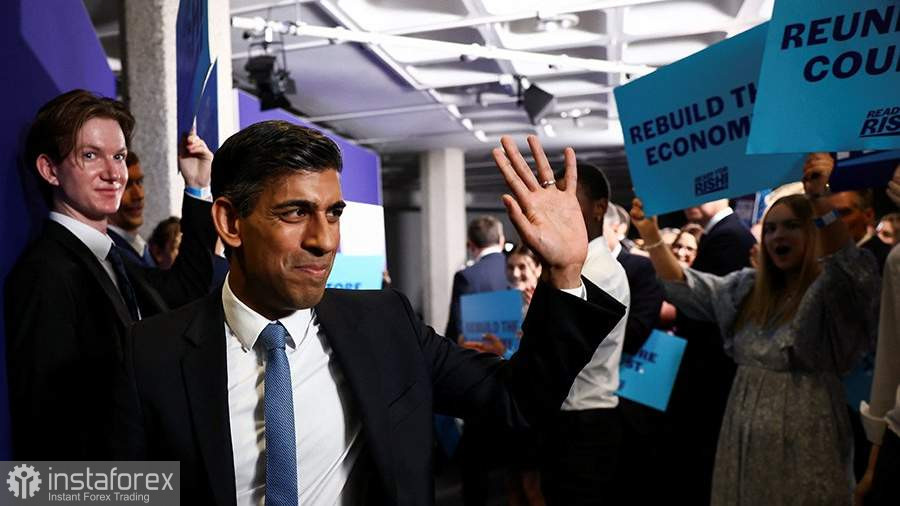The British pound is hovering as traders took a pause before crucial US inflation data. This data will determine the pair's trend for the near future. The political struggle for the post of British Prime Minister will also indirectly affect the British currency. GBP has been rising recently on expectations that the Bank of England will not raise the interest rates more aggressively. That scenario did not come true. Now, with the UK economy likely to contract for the first time since the country plunged into lockdowns in early 2021 due to the pandemic, demand for the British pound is likely to remain fairly subdued. The entire calculation for the rise in the pair will be based on a slight weakening of the US dollar.

The UK GDP is expected to contract by 0.2% in the second quarter of 2022, with annual growth of only 2.8%. The official data will be released a little later this week. A drop in economic growth would further fuel talks of a recession, as it would put a pause in the post-pandemic economic recovery and be the beginning of a prolonged recession, which the Bank of England predicts will last until 2024.
Such a forecast from the regulator is sure to complicate the prospects of Liz Truss and Rishi Sunak, who are in the race for the Prime Minister chair. Last week, the central bank released its inflation forecast, which will exceed a 40-year high and reach 13% as early as October of this year, severely affecting consumer purchasing power and pushing the economy even further into recession.
On Tuesday, YouGov's poll published in the Times, which supports Sunak, finds that a majority of voters would prefer the next prime minister to focus on fighting inflation and the looming cost-of-living crisis rather than cutting taxes.
As it was mentioned above, the economic backdrop is deteriorating rapidly as a spike in inflation makes businesses and consumers more cautious about spending. This week's GDP report is likely to show that the economy has already contracted by 1.2% in June alone this year, which coincides with the plans of the Bank of England, which warned that the UK is likely to be in recession by the fourth quarter of this year.
Energy prices are the main driver pushing inflation upward and hitting households' wallets. Starting in October, public utilities will be allowed to charge £4,000 ($4,860) a year for electricity and gas, the highest level ever and nearly four times the level of a year ago. Last week, the Bank of England said that gas prices had doubled from May, leading to a significant revision of the central bank's inflation forecast.
Last Thursday, the Bank of England raised interest rates by 50 basis points, the largest single increase since 1995. This was done to halt inflation, which economists predict will reach 13.0% this fall. The sixth consecutive increase raises the cost of borrowing to 1.75% and marks the first half-point increase since the Bank became independent of the British government in 1997. The Monetary Policy Committee voted overwhelmingly in favor of the historic half-point increase and cited rising inflationary pressures in Britain and the rest of Europe since its previous meeting in May. Only one member of the committee voted to raise rates by 0.25%.
The pound stopped falling at the beginning of this week, but buyers did not look like they wanted to buy it after the pair corrected slightly upwards. Currently, buyers need to keep the pair above 1.2050. If they manage to do this, we can expect a new big movement of the trading instrument to the level of 1.2100 and 1.2140, continuing to rise towards 1.2210. If the pair pierces that level, it may easily return to 1.2250 and 1.2290. At the same time, if the GBP/USD pair reaches above 1.2050 and we see weak activity from buyers, the situation will change dramatically, as the uptrend of July 14 will be reversed, and sellers may break through many swing lows. If there are no buyers at 1.2050, the pair is likely to correct to the area of 1.2000 with the prospect of a test of the larger level of 1.1960.
The prospect of euro growth is limited. Only fixing at 1.0210 will give buyers of risky assets an excellent chance to return to the monthly highs. The market is focusing on the inflation data in the US. The nearest resistance at 1.0210 is also crucial. If the EUR/USD pair breaks above that level, it may give confidence to buyers of risky assets and open a way to 1.0240 and 1.0290, which will determine the further uptrend from July 14. If the price reaches above 1.0290, it may test 1.0330. If the euro declines, it is very important for the buyers to hold the price above 1.0180. Otherwise, the pressure on the trading instrument will increase again. If the price goes below 1.0180, we may see it touching 1.0160. A breakthrough of this support level may increase pressure on the trading instrument, pushing it towards 1.0120.
 English
English 
 Русский
Русский Bahasa Indonesia
Bahasa Indonesia Bahasa Malay
Bahasa Malay ไทย
ไทย Español
Español Deutsch
Deutsch Български
Български Français
Français Tiếng Việt
Tiếng Việt 中文
中文 বাংলা
বাংলা हिन्दी
हिन्दी Čeština
Čeština Українська
Українська Română
Română

